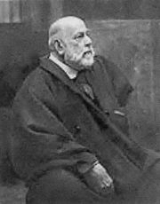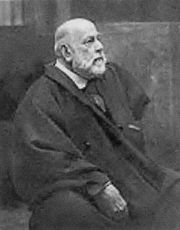
Paul-Albert Besnard
Encyclopedia
Paul-Albert Besnard was a French painter
and printmaker
.

and studied at the École des Beaux-Arts
, studied with Jean Bremond and was influenced by Alexandre Cabanel
. He won the Prix de Rome
in 1874 with the painting Death of Timophanes
Until about 1880 he followed the academic
tradition, but then broke away completely, and devoted himself to the study of colour and light as conceived by the Impressionists
. The realism of this group never appealed to his bold imagination, but he applied their technical method to ideological and decorative works on a large scale, such as his fresco
es at the Sorbonne
, the Ecole de Pharmacie, the ceiling of the Comédie-Française
(main theatre in Paris), the Salle des Sciences at the Hôtel de Ville
, the mairie of the Ier arrondissement
, and the chapel of Berck hospital, for which he painted twelve Stations of the Cross in an entirely modern spirit.
A great virtuoso, he achieved brilliant successes alike in watercolour, pastel
, oil
and etching
, both in portraiture, in landscape and in decoration. His close analysis of light can be studied in his picture “La femme qui se chauffe” at the Luxembourg in Paris, one of a large group of nude studies of which a later example is “Une Nymphe au bord de la mer”; and in the work produced during and after a visit to India in 1911. A large panel, “Peace by Arbitration,” was completed seven days before the outbreak of war in 1914.
Partly under the influence of Thomas Gainsborough
and Joshua Reynolds
, whom he studied during a three-years stay in England, he has applied his methods to a brilliant series of portraits, especially of women. Notable among these are the “Portrait de Théâtre” (Madame Réjane
), and “Mme. Roger Jourdain.” The former is a good example of his daring unconventionality. A later work is “The King and Queen of Belgium” (1919). His landscape work is represented by “L'ile heureuse,” and “Un Ruisseau dans la Montagne” (1920). A symbolist in his decorative work, Besnard's frank delight in the external world and his “chic” luminous technique bring him close to the 18th-century French painters.
A foundation member of the Société Nationale des Beaux-Arts in 1890, in 1913 he became a member of the Institute and commander of the Legion of Honour. He succeeded Carolus Duran as director of the French Academy in Rome. In 1912, he became a member of the French Académie des Beaux-Arts
and became director of the École des Beaux Arts in 1922. In 1923 he co-founded the Salon des Tuileries
; in 1924 he became a member of the Académie française
(Seat #13).
He was represented in the official exhibition of French art held in the United States
in 1919-20 by a symbolic 1917 portrait of Cardinal Mercier
. An important exhibition of his works was shown in different cities of the United States in 1924.
Painting
Painting is the practice of applying paint, pigment, color or other medium to a surface . The application of the medium is commonly applied to the base with a brush but other objects can be used. In art, the term painting describes both the act and the result of the action. However, painting is...
and printmaker
Printmaking
Printmaking is the process of making artworks by printing, normally on paper. Printmaking normally covers only the process of creating prints with an element of originality, rather than just being a photographic reproduction of a painting. Except in the case of monotyping, the process is capable...
.

Biography
He was born in ParisParis
Paris is the capital and largest city in France, situated on the river Seine, in northern France, at the heart of the Île-de-France region...
and studied at the École des Beaux-Arts
École des Beaux-Arts
École des Beaux-Arts refers to a number of influential art schools in France. The most famous is the École nationale supérieure des Beaux-Arts, now located on the left bank in Paris, across the Seine from the Louvre, in the 6th arrondissement. The school has a history spanning more than 350 years,...
, studied with Jean Bremond and was influenced by Alexandre Cabanel
Alexandre Cabanel
Alexandre Cabanel was a French painter.- Biography :Cabanel was born in Montpellier, Hérault. He painted historical, classical and religious subjects in the academic style. He was also well known as a portrait painter...
. He won the Prix de Rome
Prix de Rome
The Prix de Rome was a scholarship for arts students, principally of painting, sculpture, and architecture. It was created, initially for painters and sculptors, in 1663 in France during the reign of Louis XIV. It was an annual bursary for promising artists having proved their talents by...
in 1874 with the painting Death of Timophanes
Until about 1880 he followed the academic
Academic art
Academic art is a style of painting and sculpture produced under the influence of European academies of art. Specifically, academic art is the art and artists influenced by the standards of the French Académie des Beaux-Arts, which practiced under the movements of Neoclassicism and Romanticism,...
tradition, but then broke away completely, and devoted himself to the study of colour and light as conceived by the Impressionists
Impressionism
Impressionism was a 19th-century art movement that originated with a group of Paris-based artists whose independent exhibitions brought them to prominence during the 1870s and 1880s...
. The realism of this group never appealed to his bold imagination, but he applied their technical method to ideological and decorative works on a large scale, such as his fresco
Fresco
Fresco is any of several related mural painting types, executed on plaster on walls or ceilings. The word fresco comes from the Greek word affresca which derives from the Latin word for "fresh". Frescoes first developed in the ancient world and continued to be popular through the Renaissance...
es at the Sorbonne
University of Paris
The University of Paris was a university located in Paris, France and one of the earliest to be established in Europe. It was founded in the mid 12th century, and officially recognized as a university probably between 1160 and 1250...
, the Ecole de Pharmacie, the ceiling of the Comédie-Française
Comédie-Française
The Comédie-Française or Théâtre-Français is one of the few state theaters in France. It is the only state theater to have its own troupe of actors. It is located in the 1st arrondissement of Paris....
(main theatre in Paris), the Salle des Sciences at the Hôtel de Ville
Hôtel de Ville, Paris
The Hôtel de Ville |City Hall]]) in :Paris, France, is the building housing the City of Paris's administration. Standing on the place de l'Hôtel de Ville in the city's IVe arrondissement, it has been the location of the municipality of Paris since 1357...
, the mairie of the Ier arrondissement
Ier arrondissement
The 1st arrondissement of Paris is one of the 20 arrondissements of the capital city of France.Situated principally on the right bank of the River Seine, it also includes the west end of the Île de la Cité...
, and the chapel of Berck hospital, for which he painted twelve Stations of the Cross in an entirely modern spirit.
A great virtuoso, he achieved brilliant successes alike in watercolour, pastel
Pastel
Pastel is an art medium in the form of a stick, consisting of pure powdered pigment and a binder. The pigments used in pastels are the same as those used to produce all colored art media, including oil paints; the binder is of a neutral hue and low saturation....
, oil
Oil paint
Oil paint is a type of slow-drying paint that consists of particles of pigment suspended in a drying oil, commonly linseed oil. The viscosity of the paint may be modified by the addition of a solvent such as turpentine or white spirit, and varnish may be added to increase the glossiness of the...
and etching
Etching
Etching is the process of using strong acid or mordant to cut into the unprotected parts of a metal surface to create a design in intaglio in the metal...
, both in portraiture, in landscape and in decoration. His close analysis of light can be studied in his picture “La femme qui se chauffe” at the Luxembourg in Paris, one of a large group of nude studies of which a later example is “Une Nymphe au bord de la mer”; and in the work produced during and after a visit to India in 1911. A large panel, “Peace by Arbitration,” was completed seven days before the outbreak of war in 1914.
Partly under the influence of Thomas Gainsborough
Thomas Gainsborough
Thomas Gainsborough was an English portrait and landscape painter.-Suffolk:Thomas Gainsborough was born in Sudbury, Suffolk. He was the youngest son of John Gainsborough, a weaver and maker of woolen goods. At the age of thirteen he impressed his father with his penciling skills so that he let...
and Joshua Reynolds
Joshua Reynolds
Sir Joshua Reynolds RA FRS FRSA was an influential 18th-century English painter, specialising in portraits and promoting the "Grand Style" in painting which depended on idealization of the imperfect. He was one of the founders and first President of the Royal Academy...
, whom he studied during a three-years stay in England, he has applied his methods to a brilliant series of portraits, especially of women. Notable among these are the “Portrait de Théâtre” (Madame Réjane
Gabrielle Réjane
Gabrielle Réjane was the stage name of Gabrielle-Charlotte Reju, , a French actress.Born in Paris, the daughter of an actor, she became a pupil of Régnier at the Conservatoire, and took the second prize for comedy in 1874. Her debut was made the next year, during which she played attractively a...
), and “Mme. Roger Jourdain.” The former is a good example of his daring unconventionality. A later work is “The King and Queen of Belgium” (1919). His landscape work is represented by “L'ile heureuse,” and “Un Ruisseau dans la Montagne” (1920). A symbolist in his decorative work, Besnard's frank delight in the external world and his “chic” luminous technique bring him close to the 18th-century French painters.
A foundation member of the Société Nationale des Beaux-Arts in 1890, in 1913 he became a member of the Institute and commander of the Legion of Honour. He succeeded Carolus Duran as director of the French Academy in Rome. In 1912, he became a member of the French Académie des Beaux-Arts
Académie des beaux-arts
The Académie des Beaux-Arts is a French learned society. It is one of the five academies of the Institut de France.It was created in 1795 as the merger of the:* Académie de peinture et de sculpture...
and became director of the École des Beaux Arts in 1922. In 1923 he co-founded the Salon des Tuileries
Salon des Tuileries
The Salon des Tuileries was an annual art exhibition for painting and sculpture, created June 14, 1923, co-founded by painter Albert Besnard, sculptor Antoine Bourdelle, architect Auguste Perret, and others....
; in 1924 he became a member of the Académie française
Académie française
L'Académie française , also called the French Academy, is the pre-eminent French learned body on matters pertaining to the French language. The Académie was officially established in 1635 by Cardinal Richelieu, the chief minister to King Louis XIII. Suppressed in 1793 during the French Revolution,...
(Seat #13).
He was represented in the official exhibition of French art held in the United States
United States
The United States of America is a federal constitutional republic comprising fifty states and a federal district...
in 1919-20 by a symbolic 1917 portrait of Cardinal Mercier
Désiré-Joseph Mercier
-Early life and ordination:Désiré Mercier was born at the château du Castegier in Braine-l'Alleud, as the fifth of the seven children of Paul-Léon Mercier and his wife Anne-Marie Barbe Croquet....
. An important exhibition of his works was shown in different cities of the United States in 1924.

